Tracking Topics and Frames Regarding Sustainability Transformations during the Onset of the COVID-19 Crisis
Abstract
1. Introduction
2. Big Data and Thick Data: Methodological Considerations
3. Material and Methods
3.1. Newspapers Sample Selection
3.2. Automated Text Analysis
3.2.1. Topic Modelling
3.2.2. Quantitative Content Analysis
3.2.3. Bibliometric Analysis
3.2.4. Co-Occurrence of Sustainability Topics
3.2.5. Word Frequencies
3.2.6. Public Awareness on Sustainability
3.3. Qualitative Content Analysis
4. Results
4.1. Quantitative Analysis: Media Debate on Topics Regarding Sustainability during the Early Stages of the COVID-19 Crisis
4.1.1. Media Attention and Public Awareness on Sustainability
4.1.2. Media Statements about Sustainability (MSS) during the Onset of the COVID-Crisis
4.1.3. Co-Occurring Sustainability Topics and Keywords
4.1.4. Results Validation
4.2. Qualitative Analysis: Frames Connecting COVID-19 and Sustainability
4.2.1. The COVID-19 Crisis Led to Observable Short-Term Positive Environmental Impacts (PEIs)
4.2.2. The COVID-19 Crisis Spurred Behavioural Changes That Have an Impact on Sustainable Development (BC)
4.2.3. The COVID-19 Recovery Programme and Measures Address or Should Address Environmental Sustainability Goals (MAS)
4.2.4. The COVID-19 Recovery Measures Are Not Doing Enough to Achieve Sustainability Goals (MNDE)
4.2.5. The COVID-19 Recovery Measures Focus on the Economy First—Rollback for Sustainability (MFEF)
4.2.6. The COVID-19 Crisis Is an Opportunity for Change towards More Sustainable Development (OCS)
4.2.7. The COVID-19 Crisis Poses Challenges for Sustainability Transformations (CST)
4.2.8. The COVID-19 Crisis as an Analogy for the Climate Crisis (ACC)
5. Discussion
5.1. Empirical Findings: Evidence for a “Window of Opportunity” Narrative
5.2. Methodological Considerations: Thickening Big Data
5.3. Limitations and Further Research
6. Conclusions
Supplementary Materials
Author Contributions
Funding
Institutional Review Board Statement
Data Availability Statement
Acknowledgments
Conflicts of Interest
References
- Walby, S. Crisis; Polity Press: Cambridge, UK, 2015; ISBN 978-0745647616. [Google Scholar]
- Aldaco, R.; Hoehn, D.; Laso, J.; Margallo, M.; Ruiz-Salmón, J.; Cristobal, J.; Kahhat, R.; Villanueva-Rey, P.; Bala, A.; Batlle-Bayer, L.; et al. Food waste management during the COVID-19 outbreak: A holistic climate, economic and nutritional approach. Sci. Total Environ. 2020, 742, 140524. [Google Scholar] [CrossRef]
- You, S.; Sonne, C.; Ok, Y.S. COVID-19’s unsustainable waste management. Science 2020, 368, 1438. [Google Scholar] [CrossRef] [PubMed]
- He, G.; Pan, Y.; Tanaka, T. The short-term impacts of COVID-19 lockdown on urban air pollution in China. Nat. Sustain. 2020, 3, 1005–1011. [Google Scholar] [CrossRef]
- Ju, M.J.; Oh, J.; Choi, Y.-H. Changes in air pollution levels after COVID-19 outbreak in Korea. Sci. Total Environ. 2021, 750, 141521. [Google Scholar] [CrossRef] [PubMed]
- Lehmann, P.; Beck, S.; de Brito, M.M.; Gawel, E.; Groß, M.; Haase, A.; Lepenies, R.; Otto, D.; Schiller, J.; Strunz, S.; et al. Environmental Sustainability Post-COVID-19: Scrutinizing Popular Hypotheses from a Social Science Perspective. Sustainability 2021, 13, 8679. [Google Scholar] [CrossRef]
- Lehmann, P.; de Brito, M.M.; Gawel, E.; Groß, M.; Haase, A.; Lepenies, R.; Otto, D.; Schiller, J.; Strunz, S.; Thrän, D. Making the COVID-19 crisis a real opportunity for environmental sustainability. Sustain. Sci. 2021. [Google Scholar] [CrossRef]
- UNESCO United in Science Report: Climate Change Has Not Stopped for COVID-19. Available online: https://en.unesco.org/news/united-science-report-climate-change-has-not-stopped-covid19 (accessed on 15 October 2020).
- Sarkis, J.; Cohen, M.J.; Dewick, P.; Schröder, P. A brave new world: Lessons from the COVID-19 pandemic for transitioning to sustainable supply and production. Resour. Conserv. Recycl. 2020, 159, 104894. [Google Scholar] [CrossRef]
- Bodenheimer, M.; Leidenberger, J. COVID-19 as a window of opportunity for sustainability transitions? Narratives and communication strategies beyond the pandemic. Sustain. Sci. Pract. Policy 2020, 16, 61–66. [Google Scholar] [CrossRef]
- Hay, C. Crisis and the Structural Transformation of the State: Interrogating the Process of Change. Br. J. Polit. Int. Relations 1999, 1, 317–344. [Google Scholar] [CrossRef]
- Geels, F.W. The impact of the financial–economic crisis on sustainability transitions: Financial investment, governance and public discourse. Environ. Innov. Soc. Transit. 2013, 6, 67–95. [Google Scholar] [CrossRef]
- Haase, A.; Bedtke, N.; Begg, C.; Gawel, E.; Rink, D.; Wolff, M. On the Connection Between Urban Sustainability Transformations and Multiple Societal Crises. In Urban Transformations; Springer: Cham, Switzerland, 2018; pp. 61–76. [Google Scholar]
- Swim, J.K.; Vescio, T.K.; Dahl, J.L.; Zawadzki, S.J. Gendered discourse about climate change policies. Glob. Environ. Chang. 2018, 48, 216–225. [Google Scholar] [CrossRef]
- Moser, S.C. Communicating climate change: History, challenges, process and future directions. Wiley Interdiscip. Rev. Clim. Chang. 2010, 1, 31–53. [Google Scholar] [CrossRef]
- Pérez-González, L. ‘Is climate science taking over the science?’: A corpus-based study of competing stances on bias, dogma and expertise in the blogosphere. Humanit. Soc. Sci. Commun. 2020, 7, 92. [Google Scholar] [CrossRef]
- Weber, E.U.; Stern, P.C. Public Understanding of Climate Change in the United States. Am. Psychol. 2011, 66, 315–328. [Google Scholar] [CrossRef] [PubMed]
- Peterson, E. Not Dead Yet: Political Learning from Newspapers in a Changing Media Landscape. Polit. Behav. 2021, 43, 339–361. [Google Scholar] [CrossRef]
- Carmichael, J.T.; Brulle, R.J. Elite cues, media coverage, and public concern: An integrated path analysis of public opinion on climate change, 2001–2013. Env. Polit. 2017, 26, 232–252. [Google Scholar] [CrossRef]
- Blair, B.; Zimny-Schmitt, D.; Rudd, M.A. U.S. News Media Coverage of Pharmaceutical Pollution in the Aquatic Environment: A Content Analysis of the Problems and Solutions Presented by Actors. Environ. Manag. 2017, 60, 314–322. [Google Scholar] [CrossRef] [PubMed]
- Arlt, D.; Hoppe, I.; Wolling, J. Climate change and media usage: Effects on problem awareness and behavioural intentions. Int. Commun. Gaz. 2011, 73, 45–63. [Google Scholar] [CrossRef]
- Quesnel, K.J.; Ajami, N.K. Changes in water consumption linked to heavy news media coverage of extreme climatic events. Sci. Adv. 2017, 3, e1700784. [Google Scholar] [CrossRef]
- Kim, Y. Understanding publics’ perception and behaviors in crisis communication: Effects of crisis news framing and publics’ acquisition, selection, and transmission of information in crisis situations. J. Public Relations Res. 2016, 28, 35–50. [Google Scholar] [CrossRef]
- Moodley, P.; Lesage, S.S. A discourse analysis of Ebola in South African newspapers (2014–2015). S. Afr. J. Psychol. 2020, 50, 158–169. [Google Scholar] [CrossRef]
- Krzyżanowski, M. Brexit and the imaginary of ‘crisis’: A discourse-conceptual analysis of European news media. Crit. Discourse Stud. 2019, 16, 465–490. [Google Scholar] [CrossRef]
- De Brito, M.M.; Kuhlicke, C.; Marx, A. Near-real-time drought impact assessment: A text mining approach on the 2018/19 drought in Germany. Environ. Res. Lett. 2020, 15, 1040a9. [Google Scholar] [CrossRef]
- De Brito, M.M. Compound and cascading drought impacts do not happen by chance: A proposal to quantify their relationships. Sci. Total Environ. 2021, 778, 146236. [Google Scholar] [CrossRef] [PubMed]
- Rousseau, S.; Deschacht, N. Public Awareness of Nature and the Environment During the COVID-19 Crisis. Environ. Resour. Econ. 2020, 76, 1149–1159. [Google Scholar] [CrossRef]
- Ulibarri, N.; Scott, T.A. Environmental hazards, rigid institutions, and transformative change: How drought affects the consideration of water and climate impacts in infrastructure management. Glob. Environ. Chang. 2019, 59, 102005. [Google Scholar] [CrossRef]
- De Fortuny, E.J.; de Smedt, T.; Martens, D.; Daelemans, W. Media coverage in times of political crisis: A text mining approach. Expert Syst. Appl. 2012, 39, 11616–11622. [Google Scholar] [CrossRef][Green Version]
- Smets, A.; Lievens, B. Human Sensemaking in the Smart City: A Research Approach Merging Big and Thick Data. Ethnogr. Prax. Ind. Conf. Proc. 2018, 2018, 179–194. [Google Scholar] [CrossRef]
- Hajer, M.A.; Pelzer, P. 2050—An Energetic Odyssey: Understanding ‘Techniques of Futuring’ in the transition towards renewable energy. Energy Res. Soc. Sci. 2018, 44, 222–231. [Google Scholar] [CrossRef]
- Burrows, R.; Savage, M. After the crisis? Big Data and the methodological challenges of empirical sociology. Big Data Soc. 2014, 1, 205395171454028. [Google Scholar] [CrossRef]
- Strong, C. The challenge of “Big Data”: What does it mean for the qualitative research industry? Qual. Mark. Res. An Int. J. 2014, 17, 336–342. [Google Scholar] [CrossRef]
- Bail, C.A. The cultural environment: Measuring culture with big data. Theory Soc. 2014, 43, 465–482. [Google Scholar] [CrossRef]
- Borgman, C.L. Big data, little data, no data: Scholarship in the networked world; The MIT Press: Cambridge, MA, USA, 2015; ISBN 978-0-262-02856-1. [Google Scholar]
- Kitchin, R. Big data and human geography. Dialogues Hum. Geogr. 2013, 3, 262–267. [Google Scholar] [CrossRef]
- Mills, K.A. What are the threats and potentials of big data for qualitative research? Qual. Res. 2017, 18, 591–603. [Google Scholar] [CrossRef]
- Baur, N.; Graeff, P.; Braunisch, L.; Schweia, M. The Quality of Big Data. Development, Problems, and Possibilities of Use of Process-generated Data in the Digital Age. Hist. Soc. Res./Hist. Sozialforsch 2020, 45, 209–243. [Google Scholar] [CrossRef]
- Kitchin, R.; McArdle, G. What makes Big Data, Big Data? Exploring the ontological characteristics of 26 datasets. Big Data Soc. 2016, 3, 205395171663113. [Google Scholar] [CrossRef]
- Hesse, A.; Glenna, L.; Hinrichs, C.; Chiles, R.; Sachs, C. Qualitative Research Ethics in the Big Data Era. Am. Behav. Sci. 2019, 63, 560–583. [Google Scholar] [CrossRef]
- Felt, M. Social media and the social sciences: How researchers employ Big Data analytics. Big Data Soc. 2016, 3, 205395171664582. [Google Scholar] [CrossRef]
- Morgan, D.L. Integrating Qualitative and Quantitative Methods: A Pragmatic Approach; SAGE Publications, Inc.: London, UK, 2014; ISBN 9780761915232. [Google Scholar]
- Bornakke, T.; Due, B.L. Big–Thick Blending: A method for mixing analytical insights from big and thick data sources. Big Data Soc. 2018, 5, 2053951718765026. [Google Scholar] [CrossRef]
- Geertz, C. The Interpretation of Cultures; Basic Books: New York, NY, USA, 1973. [Google Scholar]
- Ponterotto, J. Brief Note on the Origins, Evolution, and Meaning of the Qualitative Research Concept Thick Description. Qual. Rep. 2006, 11, 538–549. [Google Scholar]
- Levandowsky, M.; Winter, D. Distance between Sets. Nature 1971, 234, 34–35. [Google Scholar] [CrossRef]
- Callaghan, M.W.; Minx, J.C.; Forster, P.M. A topography of climate change research. Nat. Clim. Chang. 2020, 10, 118–123. [Google Scholar] [CrossRef]
- Luiz, O.J.; Olden, J.D.; Kennard, M.J.; Crook, D.A.; Douglas, M.M.; Saunders, T.M.; King, A.J. Trait-based ecology of fishes: A quantitative assessment of literature trends and knowledge gaps using topic modelling. Fish Fish. 2019, 20, 1100–1110. [Google Scholar] [CrossRef]
- Aachener Stiftung Lexikon der Nachhaltigkeit. Available online: https://www.nachhaltigkeit.info/suche/a-z/b/index.htm (accessed on 4 October 2021).
- GreenFacts Glosar Nachhaltigkeit. Available online: https://www.greenfacts.org/de/glossar/abc/index.htm (accessed on 4 October 2021).
- Sachs, J.; Schmidt-Traub, G.; Kroll, C.; Lafortune, G.; Fuller, G. Sustainable Development Report 2019. 2019. Available online: https://www.sdgindex.org/reports/sdg-index-and-dashboards-2018/ (accessed on 4 October 2021).
- Youngblood, M.; Lahti, D. A bibliometric analysis of the interdisciplinary field of cultural evolution. Palgrave Commun. 2018, 4, 120. [Google Scholar] [CrossRef]
- Krzywinski, M.; Schein, J.; Birol, I.; Connors, J.; Gascoyne, R.; Horsman, D.; Jones, S.J.; Marra, M.A. Circos: An information aesthetic for comparative genomics. Genome Res. 2009, 19, 1639–1645. [Google Scholar] [CrossRef]
- Schreier, M. Qualitative Content Analysis in Practice; SAGE: Los Angeles, CA, USA, 2012; ISBN1 978-1-84920-592-4. ISBN2 978-1-84920-593-1. [Google Scholar]
- Mayring, P. Qualitative Content Analysis. Forum Qual. Sozialforsch. Forum Qual. Soc. Res. 2000, 1. [Google Scholar] [CrossRef]
- Topham, G.; Harvey, F. Carmakers Accused of Trying to Use Crisis to Avert Emissions Crackdown. 2020. Available online: https://www.theguardian.com/business/2020/mar/27/carmakers-accused-of-using-covid-19-weaken-environmental-laws (accessed on 4 October 2021).
- Simon, F. Green Deal Facing Delays Due to Coronavirus, EU Admits. 2020. Available online: https://www.euractiv.com/section/energy-environment/news/green-deal-facing-delays-due-to-coronavirus-eu-admits/ (accessed on 4 October 2021).
- Engler, J.-O.; Abson, D.J.; von Wehrden, H. The coronavirus pandemic as an analogy for future sustainability challenges. Sustain. Sci. 2021, 16, 317–319. [Google Scholar] [CrossRef]
- Williams, S.; Robinson, J. Measuring sustainability: An evaluation framework for sustainability transition experiments. Environ. Sci. Policy 2020, 103, 58–66. [Google Scholar] [CrossRef]
- Almoradie, A.; Brito, M.M.; Evers, M.; Bossa, A.; Lumor, M.; Norman, C.; Yacouba, Y.; Hounkpe, J. Current flood risk management practices in Ghana: Gaps and opportunities for improving resilience. J. Flood Risk Manag. 2020, 13, e12664. [Google Scholar] [CrossRef]
- Zhang, D.; Hao, M.; Morse, S. Is Environmental Sustainability Taking a Backseat in China after COVID-19? The Perspective of Business Managers. Sustainability 2020, 12, 10369. [Google Scholar] [CrossRef]
- Barreiro-Gen, M.; Lozano, R.; Zafar, A. Changes in Sustainability Priorities in Organisations due to the COVID-19 Outbreak: Averting Environmental Rebound Effects on Society. Sustainability 2020, 12, 5031. [Google Scholar] [CrossRef]
- Barbier, E.B.; Burgess, J.C. Sustainability and development after COVID-19. World Dev. 2020, 135, 105082. [Google Scholar] [CrossRef] [PubMed]
- Nature. Time to revise the Sustainable Development Goals. Nature 2020, 583, 331–332. [Google Scholar] [CrossRef] [PubMed]
- Naidoo, R.; Fisher, B. Reset Sustainable Development Goals for a pandemic world. Nature 2020, 583, 198–201. [Google Scholar] [CrossRef] [PubMed]
- Davidson, E.; Edwards, R.; Jamieson, L.; Weller, S. Big data, qualitative style: A breadth-and-depth method for working with large amounts of secondary qualitative data. Qual. Quant. 2019, 53, 363–376. [Google Scholar] [CrossRef] [PubMed]
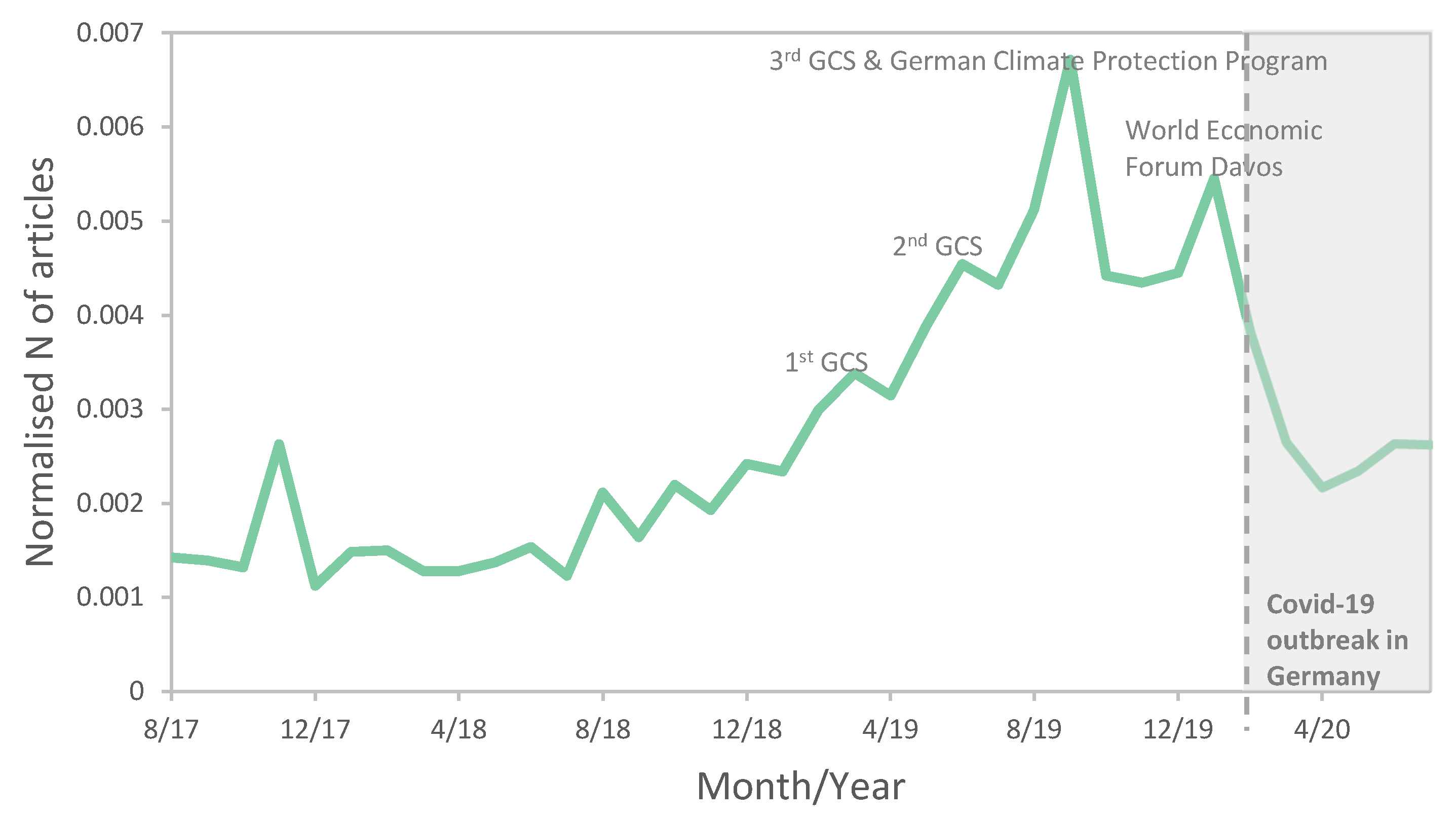
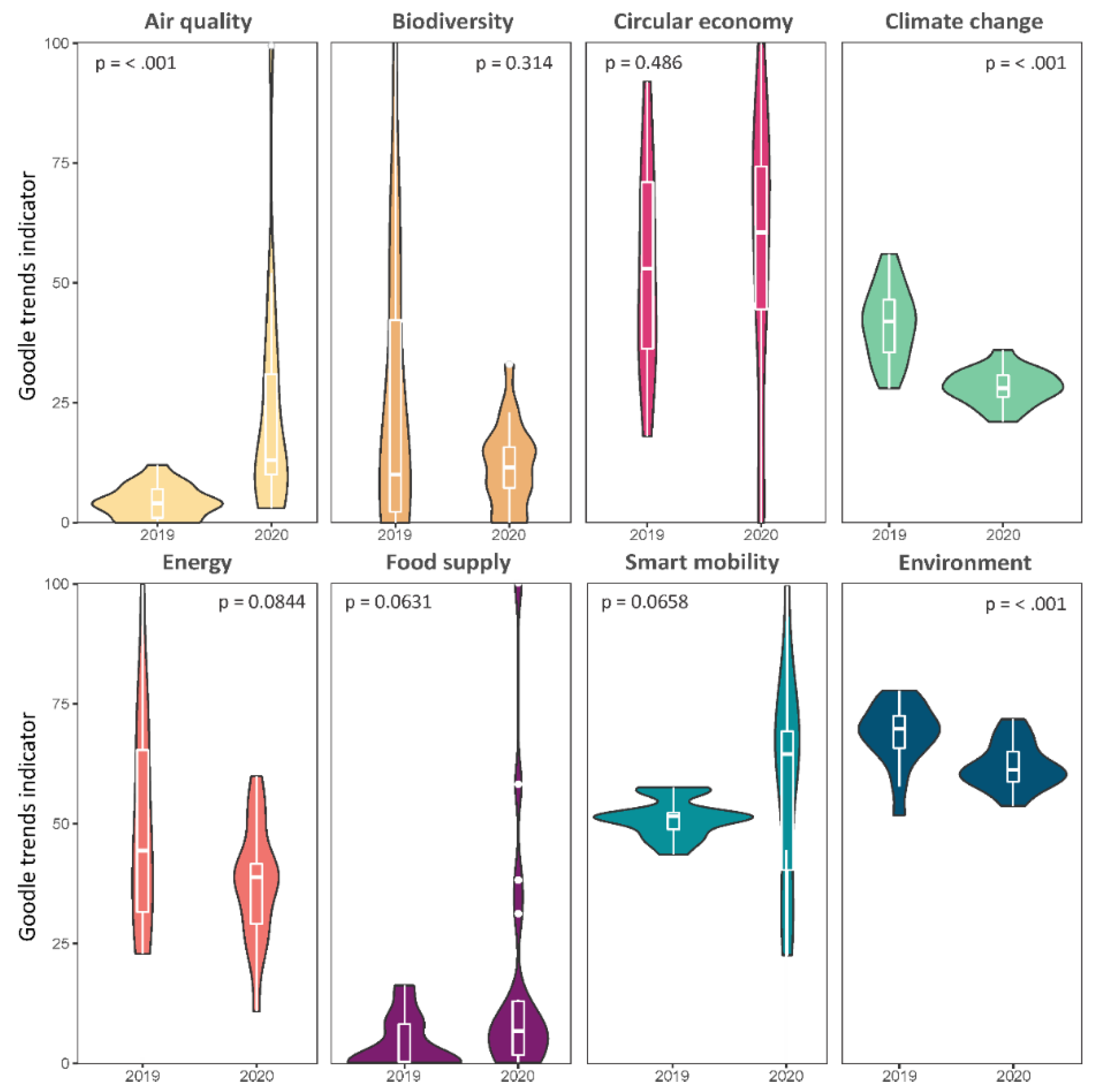
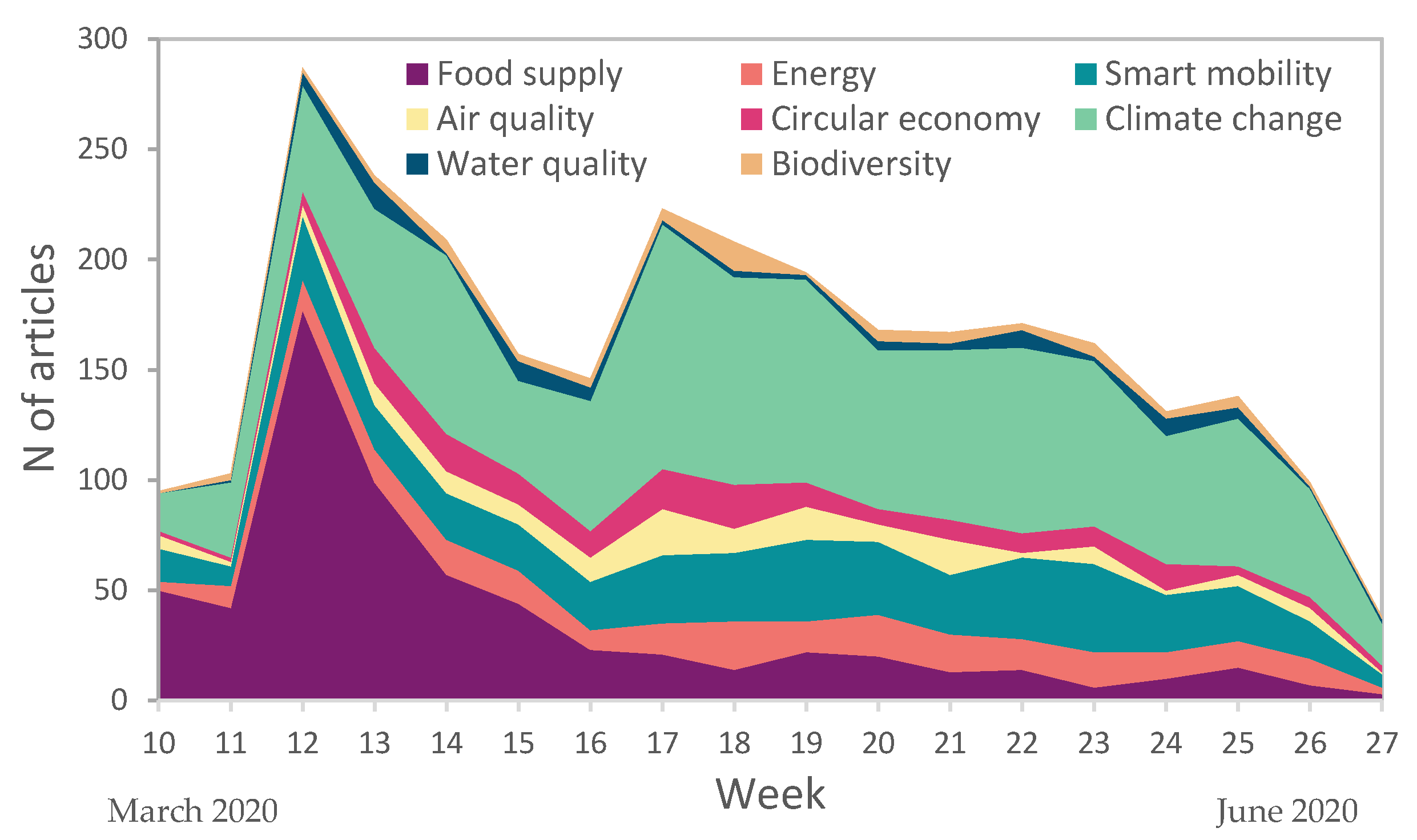
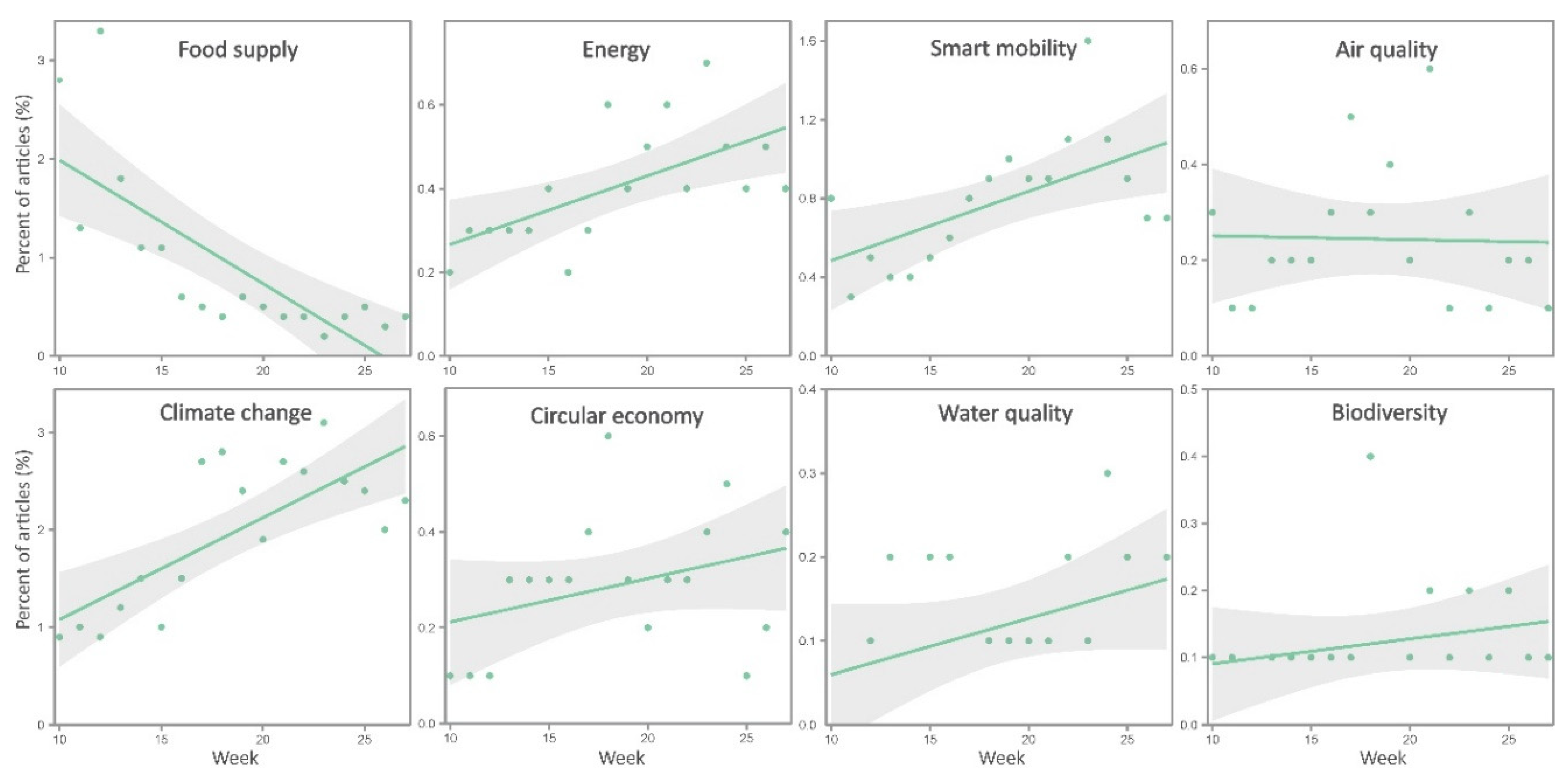

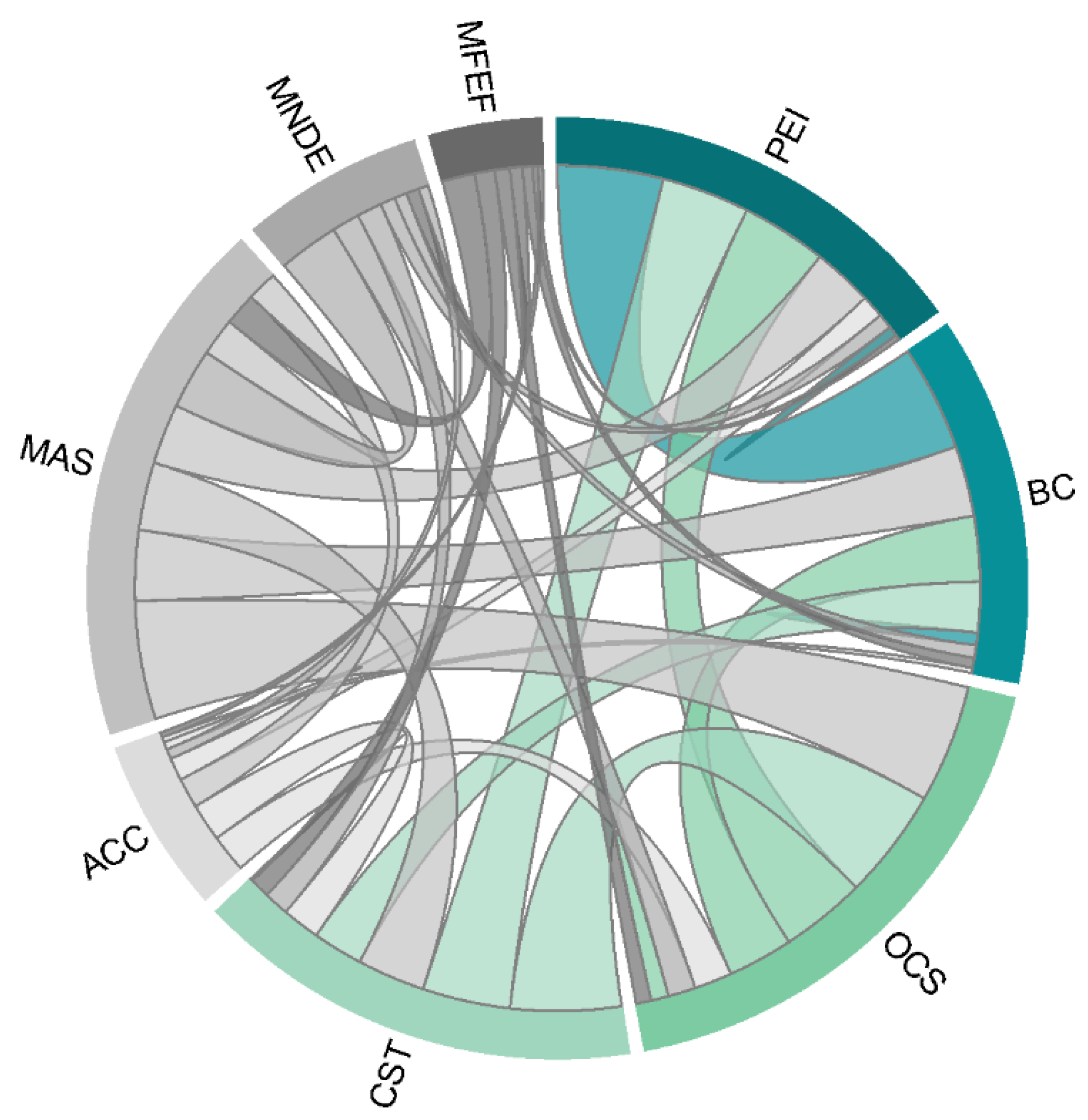
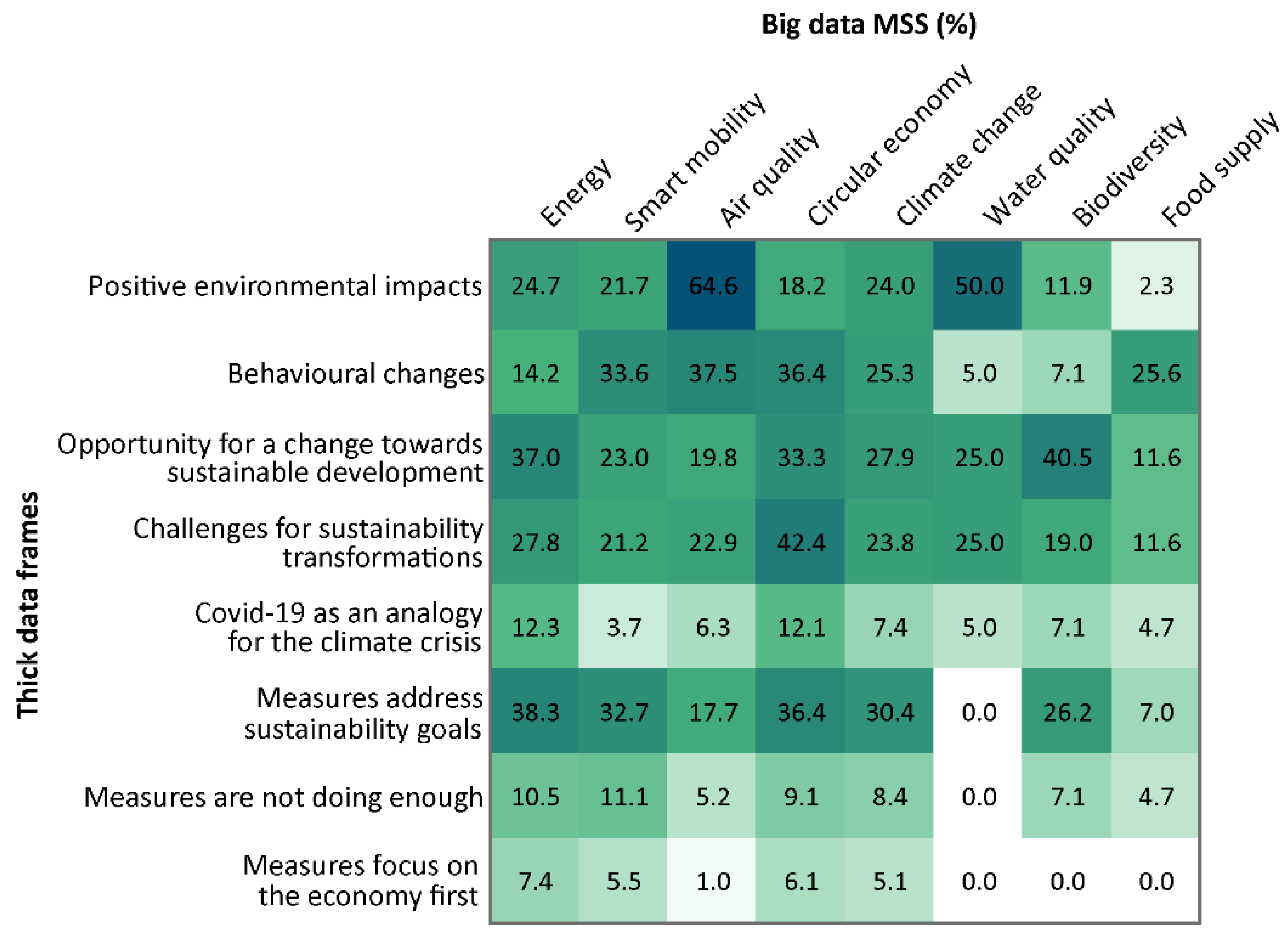

| Category | COVID-19 Sustainability Frame | % |
|---|---|---|
| COVID-19 impacts with implications for the SDGs and Green Deal goals | The COVID-19 crisis led to observable short-term Positive Environmental Impacts (PEIs) | 23.4 |
| The COVID-19 crisis spurred Behavioural Changes that have an impact on sustainable development (BC) | 24.3 | |
| COVID-19 recovery measures and their relation to the SDGs and Green Deal goals | The COVID-19 recovery programme and Measures Address or should address environmental Sustainability goals (MAS) | 27.3 |
| The COVID-19 recovery Measures are Not Doing Enough to achieve sustainability goals (MNDE) | 7.4 | |
| The COVID-19 recovery Measures Focus on the Economy First (MFEF) | 4.6 | |
| COVID-19 as a window of opportunity for sustainability transformations | The COVID-19 crisis is an Opportunity for Change towards more Sustainable development (OCS) | 25.5 |
| The COVID-19 crisis poses Challenges for Sustainability Transformations (CST) | 21.9 | |
| The COVID-19 crisis as an Analogy for the Climate Crisis (ACC) | 6.3 |
Publisher’s Note: MDPI stays neutral with regard to jurisdictional claims in published maps and institutional affiliations. |
© 2021 by the authors. Licensee MDPI, Basel, Switzerland. This article is an open access article distributed under the terms and conditions of the Creative Commons Attribution (CC BY) license (https://creativecommons.org/licenses/by/4.0/).
Share and Cite
de Brito, M.M.; Otto, D.; Kuhlicke, C. Tracking Topics and Frames Regarding Sustainability Transformations during the Onset of the COVID-19 Crisis. Sustainability 2021, 13, 11095. https://doi.org/10.3390/su131911095
de Brito MM, Otto D, Kuhlicke C. Tracking Topics and Frames Regarding Sustainability Transformations during the Onset of the COVID-19 Crisis. Sustainability. 2021; 13(19):11095. https://doi.org/10.3390/su131911095
Chicago/Turabian Stylede Brito, Mariana Madruga, Danny Otto, and Christian Kuhlicke. 2021. "Tracking Topics and Frames Regarding Sustainability Transformations during the Onset of the COVID-19 Crisis" Sustainability 13, no. 19: 11095. https://doi.org/10.3390/su131911095
APA Stylede Brito, M. M., Otto, D., & Kuhlicke, C. (2021). Tracking Topics and Frames Regarding Sustainability Transformations during the Onset of the COVID-19 Crisis. Sustainability, 13(19), 11095. https://doi.org/10.3390/su131911095






